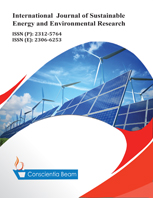Torrefaction of Oil Palm Frond using Dry Flue Gas
DOI:
https://doi.org/10.18488/13.v11i1.3060Abstract
This study aimed to experimentally investigate the effects of dry flue gas on biomass torrefaction. In this work, an oil palm frond (OPF) was torrefied in a laboratory-scale horizontal torrefaction reactor at temperatures of 240, 260, and 280 °C, with a residence time of 20 and 40 min, using dry flue gas with variable compositions (N2/CO2/O2: 76/16/8, 80/14/6, and 74/12/4). In addition, the experiments of conventional torrefaction were conducted for comparison. The effects of operating parameters on mass yield, the proximate and ultimate analysis, and the heating value of the fuel were investigated. The proposed method improved the fuel property of OPF substantially. With dry flue gas, OPF had lower moisture and volatile, and higher fixed carbon. The heating value of the selected biomass increased from 14.6 MJ/kg to 25.8 MJ/kg. Therefore, torrefaction using dry flue gas exhibited a potential for practical use for the biomass fuel pre-treatment method. However, this method resulted in a decreased mass yield and, consequently, the energy yield of the sample compared to conventional torrefaction.

